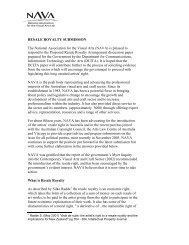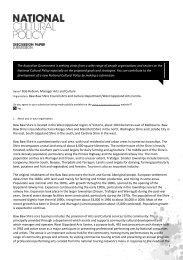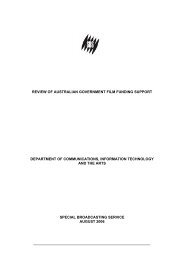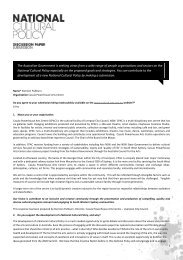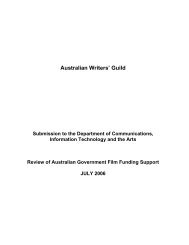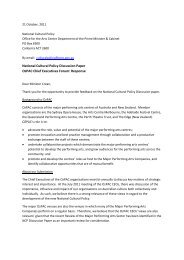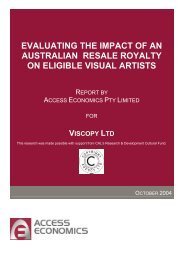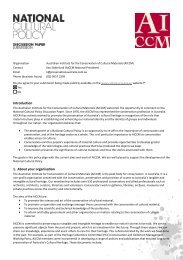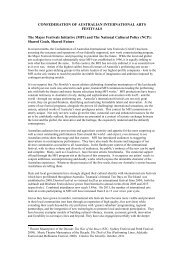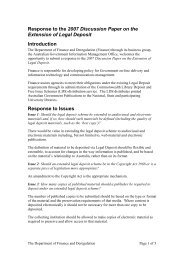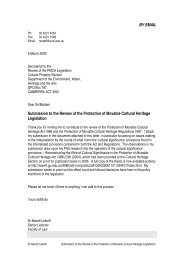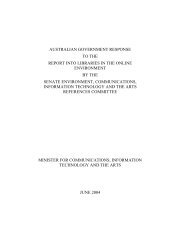Discussion paper (PDF - 459 KB)
Discussion paper (PDF - 459 KB)
Discussion paper (PDF - 459 KB)
You also want an ePaper? Increase the reach of your titles
YUMPU automatically turns print PDFs into web optimized ePapers that Google loves.
Immunity from Seizure forCultural Objects on Loan<strong>Discussion</strong> Paper2011
Immunity from Seizure for Cultural Objects on Loan - <strong>Discussion</strong> Paper 2011SubmissionsSubmissions should provide as much factual and example-based input aspossible.Please direct your submissions to this discussion <strong>paper</strong> to:IFSconsultation@pmc.gov.auORPublic Consultation on Immunity from SeizureOffice for the ArtsPO Box 6500Canberra ACT 2600Questions about the consultation can be directed to +61 2 6275 9956 or tothe above email address.Submissions may be published on the www.arts.gov.au website. Forsubmissions from individual community members, the publication ofcontact details will be limited to name and state unless marked confidential.If you require your submission to be treated as confidential please note thisclearly on the cover page, and in the subject line if sent via email.The closing date for submissions is 28 August 2011
Immunity from Seizure for Cultural Objects on Loan - <strong>Discussion</strong> Paper 2011ContentsIntroduction 4<strong>Discussion</strong> <strong>paper</strong> 4Immunity from Seizure for cultural objects on loan 4Immunity from Seizure in the Australian Context 5Current legislative framework 5Impact on loans 5Scope of provisions 6Community Benefits 7Social and cultural impacts 7Economic significance 7Impact of Seizures 8Protection of objects 8Reputation of borrowers 8International Considerations 8International responsibilities and obligations 8International context and foreign statutes 9Features of existing models 9Policy Considerations in Developing a Model forAustralia (questions) 10Hypothetical Model 16Appendices 19A: Australia’s Current Legislative Framework 19B: International Context and Foreign Statutes 21
Immunity from Seizure for Cultural Objects on Loan - <strong>Discussion</strong> Paper 2011Introduction<strong>Discussion</strong> <strong>paper</strong>Currently Australia does not have comprehensive immunity from seizure legislation in place whichprotects objects from seizure whilst on loan to collecting institutions. The Commonwealth, with thecooperation of the states and territories, is currently investigating this issue to gain a wider perspectiveon the impact a lack of this type of legislation is having, or is likely to have, in the Australian context.The purpose of this discussion <strong>paper</strong> is to encourage submissions which will inform any future policyconsideration of this issue.For the purposes of this discussion <strong>paper</strong> a series of policy questions have been developed, followedby a separate hypothetical model which outlines one possibility for the operation of immunity fromseizure in Australia. These should be viewed separately for the purpose of making any submission onthe matter and are not intended to propose a plan for implementation by the Australian Governmentbut rather generate input during this consultation period which can be used to inform future directionon the issue.Immunity from seizure for cultural objects on loanImmunity from seizure for cultural objects on loan (hereafter ‘immunity from seizure’) broadly meansproviding protection against potential claims on cultural heritage objects lent by an international ordomestic collection to cultural agencies, including, but not limited to, museums, galleries, libraries andarchives (hereafter ‘collecting institutions’), for the duration of the loan. It is essentially a guaranteethat objects on temporary loan from another country will be protected against seizure, and, in somecases, suit (defined as any legal proceedings brought to a court of law), during the period of the loan.Benefits of immunity from seizure when implemented in other countries have included:• reducing the risk involved in cross–border loans for collecting institutions;• providing surety for the lender and allowing mobility of collections between collectinginstitutions for the publicly beneficial exhibition of significant objects;• allowing lending procedures to become streamlined and more transparent;• improving the due diligence of borrowing institutions which are required to meet particularstandards in order to gain access to immunity provisions.There are three main scenarios in which the seizure of objects on loan becomes a risk:1. A government, company or individual lays claim to the ownership of an object, and bringslegal proceedings to have their ownership recognised and/or to take possession of theobject.2. Where the object or objects are seized as part of the enforcement of a judgment againstthe owner (where the owner is in debt, or as part of divorce proceedings for example).These types of claims can be unrelated to title or provenance, with the object being treatedsimply as property of some value.3. Where the object or objects are seized as part of a criminal investigation (includingproceeds of crime, etc).4
Immunity from Seizure for Cultural Objects on Loan - <strong>Discussion</strong> Paper 2011Immunity from Seizure in the Australian ContextThe Australian Government is aware that Australia’s current lack of comprehensive immunity fromseizure legislation is a matter of growing concern in the collecting sector. The issue has been raisedwith the Australian Government by a number of collecting institutions and professional bodies acrossAustralia over the past 18 months. Feedback from Australian collecting institutions has suggested thatthey are experiencing increasing reluctance by overseas institutions and individuals to lend objectsfor exhibition in Australia, due to concerns about their potential seizure by third party claimants. Suchclaims may relate to objects that are nationally significant and could trigger attempts to have themremain permanently in Australia or to foreign culturally significant objects that may be claimed to havebeen illegally acquired from their original owners, illegally exported from their country of origin orclaimed as part of an unrelated legal dispute (or judgment against the owner in a foreign court) withthe current owner, the lending institution or the country in which the lending institution is located.To respond to the concerns of lenders, some Australian collecting institutions offer ‘letters of comfort’which outline the Australian legislative framework applicable to objects on loan. However, feedbackfrom the collecting sector suggests that lenders are increasingly finding these insufficient, and areasking for immunity guarantees, as well as raising questions about the limitations of the protectionsoffered by existing provisions.Current legislative frameworkAustralia’s existing legislative measures offering protection from seizure apply only in specific andlimited circumstances. These are established by the Protection of Movable Cultural Heritage Act 1986(Cth) (PMCH Act), and the Foreign States Immunities Act 1985. Summaries of these measures can befound at Appendix A.Impact on loansThe galleries, libraries, archives and museums sector has argued that the absence of comprehensiveimmunity legislation in Australia is hampering the capacity of Australian institutions to compete forloans when such legislation exists in a growing number of other countries.The Australian Government has been provided with several instances in which the request for the loanof a particular object or work has been refused due to Australia’s lack of immunity provisions, or whereexpected works have not been received by a borrowing institution due to the lenderwithdrawing the loan at the last minute. In recent years, the request for the provision of immunityprotection by overseas lenders has increased significantly, with many Australian collecting institutionsfinding it increasingly difficult to seek and proceed with loans.5
Immunity from Seizure for Cultural Objects on Loan - <strong>Discussion</strong> Paper 2011Scope of provisionsRestitution claimsIt should be noted that if immunity from seizure provisions were to be adopted, they would have noimpact on restitution claims for objects in Australian or international collections outside the periodof immunity. Immunity provisions would only protect against claims being raised in Australian courtswhich were taking advantage of the object or collection’s temporary presence within Australianterritory. Immunity from seizure legislation would not remove the requirement for institutions toperform due diligence and proper provenance research (with recognition of the wide variety of styleswhich provenance research can take depending on the object and circumstances), nor would it affectAustralia’s obligations under international treaties and conventions to which it is a party.Illicit tradeThe Australian Government recognises the growing problem of illicit trade in cultural property, andrecognises the economic, social and cultural damage this trade inflicts on society. Australia is a partyto the 1970 UNESCO Convention on the Means of Prohibiting and Preventing the Illicit Export andTransfer of Ownership of Cultural Property and is interested in worldwide efforts which encourage theseizure and repatriation of stolen and illegally exported objects.Due diligenceAny consideration of immunity from seizure provisions in Australia will be aimed at supporting greateropportunities for the Australian public to view significant cultural objects, and allowing Australia’sinstitutions to compete with international institutions for loans of such objects. It will not beintroduced to provide support or protection for lenders or borrowers who do not comply withrecognised international standards of due diligence (for example the ICOM code of ethics andMuseums Australia code of ethics). Loans which do not meet such standards would not be eligible forprotection under any potential form of immunity from seizure legislation.6
Immunity from Seizure for Cultural Objects on Loan - <strong>Discussion</strong> Paper 2011Community benefitsThe movement of cultural property between nations has a long tradition, and is an activity which hasthe potential to bring significant social, economic and cultural benefits to both the lending andborrowing communities. It advances cultural diplomacy, enhances the study of artists, movements,societies and cultures, and allows for a better understanding of our world and the people and cultureswhich exist within it. The Australian Government recognises the important role that exhibitions play inthe Australian social, cultural and economic landscape.Social and cultural impactsThere are numerous social and cultural benefits that come with the exhibition of significant culturalmaterial. Particularly when done for the purposes of public exhibition, the loan of cultural propertycan be very influential and significant, allowing people in a relatively remote country like Australia toexperience and view objects which tell a story about the human and natural history of the world.Bringing these objects to Australia promotes accessibility, new inspiration for current and futureartists, historians and anthropologists and educational opportunities for the public which ensures theircontinued cultural engagement.They also have an important educational impact, with school groups being one of the largest audiencetypes to visit international exhibitions. With a focus on the arts and history in the new nationalcurriculum, exposure to cultural objects, artworks and other creative works from overseas will becomeincreasingly important in providing a tangible connection for Australians students to their studies.Curated exhibitions which bring together works from separate collections can inform and enlightenhistorians and artists; provide influence on academic and artistic output; and expose all visitors towider aspects of an artist or movement’s work.Economic significanceThe loan of cultural objects for public exhibition is economically significant. Exhibitions which arepopular and draw the interest of the broader community can provide an enormous boost to localeconomies. In 2009-10 the Masterpieces from Paris exhibition at the National Gallery of Australiabroke attendance records for public exhibitions in Australia, and boosted the ACT economy by morethan $90 million. It also attracted thousands of Australians to the national capital, many as first timevisitors, and increased visitation at other national collecting institutions such as the National PortraitGallery and the Australian War Memorial.This kind of economic impact can be seen Australia-wide, with Victoria’s Winter Masterpieces programdrawing large numbers of visitors each year (220,000 to 333,000). Combined with offering jointexhibition tickets which allow visitors to experience concurrent exhibitions at the National Gallery ofVictoria, Museum Victoria and the Australian Centre for the Moving Image it encourages culturalengagement and boosts the Victorian economy in excess of $130 million collectively.7
Immunity from Seizure for Cultural Objects on Loan - <strong>Discussion</strong> Paper 2011Impact of SeizuresProtection of objectsConcern has been raised internationally that the seizure of cultural objects whilst on loan to foreigninstitutions can cause significant damage, both to the physical objects and to the reputation of thelender and borrower. Professional conservators and object handlers receive high-level training in themovement and storing of objects, but are not always present when a seizure takes place. In the processof being physically seized, it is possible significant objects could be mishandled or storedinappropriately, causing damage or cultural insult. For example, there is the potential that they may beseen by inappropriate people (men seeing women’s sacred and secret ritual objects and vice versa) orobjects which were subject to strict display and storage requirements may be photographed or storedin an inappropriate environment.Reputation of borrowersIf an item is seized, great damage can be caused to the reputation of the borrowing institution which,in spite of having conducted thorough provenance checks, may become subject to an unforseen thirdparty claim. Such an event can result in the dissolution of trust between the borrowing institution andoverseas lenders, and attract suspicion or wariness when institutions in the same jurisdiction competefor loans in the future. In short, one seizure in a particular country can negatively impact all potentialborrowing institutions in that country.International ConsiderationsInternational responsibilities and obligationsAny Australian provisions for immunity from seizure would need to be balanced with measures thatenable the return of cultural property to genuine claimants in accordance with Australia’s obligationsunder the UNESCO Convention on the Means of Prohibiting and Preventing the Illicit Import, Exportand Transfer of Ownership of Cultural Property 1970 (the 1970 Convention). This convention covers abroad range of issues aimed at protecting cultural objects, including obliging all parties to takeappropriate steps to recover and return stolen or illicitly exported objects, primarily throughdiplomatic channels.Additionally, as part of the review of the PMCH Act in 2009, the Australian Government is consideringissues surrounding accession to the UNIDROIT Convention on Stolen or Illegally Exported CulturalObjects 1995. To date, 31 countries have ratified or acceded to this Convention, which aims tocomplement the 1970 Convention. Any Australian immunity from seizure provisions would also needto be balanced with the UNIDROIT Convention, should Australia move to become a party to it.8
Immunity from Seizure for Cultural Objects on Loan - <strong>Discussion</strong> Paper 2011International context and foreign statutesIn preliminary consultations on the issue of immunity from seizure it was noted that internationalconsistency of approaches to the issue is desirable. Although models vary greatly, it would be usefulto consider what types of processes are undertaken internationally and which may be appropriate inthe Australian context.Appendix B provides an overview of the international models of immunity from seizure provisions. Itaims to highlight the variances and key points of the different models in operation; however it is not acomprehensive summary of the legislation that is in place in these countries.Features of existing modelsInternationally, models for immunity from seizure legislation typically comprise one or more of thefollowing features:• Automatic immunityObjects which are on loan to cultural institutions for temporary exhibition areautomatically granted immunity from seizure during the term of the loan.• Sovereign ImmunityObjects which are on loan from a foreign State, i.e., owned by a foreign government, areprotected from seizure, suit and any judicial action.• Immunity after applicationAn application, usually including detailed provenance information and details of theexhibition/purpose of the loan, is submitted to the relevant government body by thecultural institution proposing to borrow the objects, prior to the exhibition’s importation.• Publication as part of the applicationDetails of the intended loan objects are published, usually including images, on theborrowing institution’s and/or government’s website. This may be followed by a period ofnon-objection to the loan prior to immunity becoming effective and importation takingplace.• Accredited/approved institutionsInstitutions undergo an assessment process to become ‘approved’ institutions which areeligible for immunity. Immunity for objects loaned to these institutions is either automaticor becomes effective after certain conditions are met (such as due diligence proceduresand the publication of intended loans). Where such systems of accreditation are in placethere is often a process for review and reporting to ensure compliance. It should be notedthat some instances of accreditation systems in place internationally require heavyadministration from the government agency which oversees them.9
Immunity from Seizure for Cultural Objects on Loan - <strong>Discussion</strong> Paper 2011Policy Considerations in Developing a Model for AustraliaThe Australian Government is interested in gaining a wide range of views on the issue of immunityfrom seizure. There are several policy considerations for the Government in considering immunityfrom seizure legislation. The questions asked in this section of the discussion <strong>paper</strong> are intended toinvite comment and input into the future development of any policy on this matter.It would be useful for submissions to respond to the key issues raised, however these issues are onlyintended to guide, rather than limit, the submissions. Additional comments relating to theimmunity from seizure issue not addressed in this discussion <strong>paper</strong> are welcome.Do you generally support the implementation of legislation which wouldprovide immunity from seizure and suit for cultural objects on loan to Australia?Are there specific examples or evidence as to the impacts an absence of immunity from seizurelegislation is having in Australia? Alternatively, can you foresee any negative impact immunity fromseizure legislation would have? Questions on the type of model, scope of legislation etc. will beaddressed further, below.1. Exemption for Australian Protected Objects as defined by the PMCH ActShould Australian Protected Objects be excluded from coverage under potential immunity fromseizure legislation?The Australian Government is interested in gaining input and opinion on the possibility of limitingimmunity from seizure protection to objects on loan which are not classified as Australian ProtectedObjects (APOs) under the PMCH Act. The Government has already recognised, and established inCommonwealth legislation, that these objects are of significance to Australia. It is thereforeforeseeable that claims may be made on such objects whilst they are in Australia, which could not bemade in other countries, and preventing such actions may infringe on the human rights ofindividuals. Australian related objects which are not APOs may be eligible for immunity protection inthe same manner as other types of objects in potential immunity from seizure legislation.The Control List, which sets out what objects are classified as an APO can be found in the PMCHRegulations here: http://www.comlaw.gov.au/Details/F2004C00105.Objects which fit the criteria of being APOs are currently provided with the option of receiving aCertificate of Exemption under the PMCH Act.Please note that any future immunity from seizure legislation enacted in Australia would likelyrequire applicants to ensure they apply for certificates of exemption under the PMCH Act as well asapplying for immunity.10
Immunity from Seizure for Cultural Objects on Loan - <strong>Discussion</strong> Paper 20112. Types of claimsWhat types of claims should be prevented or allowed under this type of legislation? ShouldAustralia consider immunity from seizure with a return guarantee for the object, but not preventother types of claims for damages, compensation, etc.?The types of third party claims that are prevented by an immunity statute vary amongst foreign modelsof immunity from seizure provisions. The types of claims other countries have protected against haveincluded ownership claims seeking the seizure and return of objects, but also claims for damages orfinancial compensation.What types of claims should be allowed to ensure international ethical guidelines and obligations aremet? What types of claims should be prevented (e.g. claims relating to damages/financialcompensation (unjust enrichment), seizure due to sedition/indecency/obscenity, unrelated private legaldisputes (as an asset for the repayment of debt) etc. Should the borrower be immune from legalremedies that do not involve the seizure or physical confinement of the object?3. PublicationIf a publication requirement was to form part of an Australian model of immunity from seizure, whatwould be the best way to disseminate this information (online, in a news<strong>paper</strong>, etc.)?Please note that the responsibility for the publication of objects under application for immunityprotection may rest with the borrower.Can you foresee any problems with requiring the publication of objects under application? What arethe benefits? What would be the best methods of publication to ensure broad public exposure to theitems being considered for immunity protection? Are there cases in which publication is notappropriate or should not occur?11
Immunity from Seizure for Cultural Objects on Loan - <strong>Discussion</strong> Paper 20114. Loan purposesFor what purposes should loans be undertaken to make them eligible for immunity protection?The types of loan purposes that could be considered for immunity measures include cultural,educational, research, digitisation, conservation and/or charitable purposes. Some countriesexclude from coverage the loan of objects which are imported for profit-making exhibitions, or for thepurposes of sale. Some countries also do not cover objects being imported for research purposes.The Australian Government is interested in gaining input on this issue, with particular regard to thescale of the coverage, what type of loans should be included in coverage, and under whatcircumstances an object should be provided with immunity. Should provision of immunity be restrictedto the import of objects for cultural, educational, research or charitable reasons? Are there any loanpurposes under which objects should be ineligible for immunity coverage? Should ‘research’ be broadlyopen or be defined as anthropological, scientific or cultural? Should objects being imported as part ofa ‘for profit’, or commercial exhibition be excluded from eligibility (i.e. an exhibition where any profitsare not used to support the functions of the borrowing institution through the care, maintenance orgrowth of the existing permanent collection, and/or where profits go towards shareholders or privatesector companies)?5. Australian Indigenous movable cultural heritageRecognising the unique challenges faced by Indigenous communities in relation to their culturalmaterial, should extra provisions be made to ensure appropriate protection?Numerous tangible representations of Australia’s diverse Indigenous heritage have been acquired overcenturies and placed into collections all over the world. As with other types of cultural objects, theprovenance of some of these is unclear and in some cases impossible to determine. It cannot beassumed that all Australian Indigenous cultural objects held overseas were stolen, or inappropriatelyor illegally acquired, and likewise it cannot be assumed that they were legitimately acquired. Thehypothetical model provided in this discussion <strong>paper</strong> proposes that Australian Protected Objects(APOs), as defined by the PMCH Act, will not be eligible for immunity. The PMCH Act control list, whichclassifies what constitutes an APO, provides for a broad range of Indigenous cultural objects to beclassified as APOs. Again, the control list for the PMCH Act can be found here:http://www.comlaw.gov.au/Details/F2004C00105Please note: any future immunity from seizure legislation implemented by the AustralianGovernment will not provide immunity protection or coverage for human remains. This need not beaddressed in any submissions.Does preventing immunity for Australian Indigenous objects classed as APOs adequately recognise thechallenges and ethical considerations in relation to this material? What, if any, other types of objects(which are not considered APOs) should not be eligible for coverage? Under what circumstances shouldIndigenous material be refused immunity protection? What consultation or communication withcommunities should be carried out by the borrower before objects are considered for loan? Is it fair thatthere may be additional requirements on borrowers which differ from the standards required for othertypes of objects? Are there other suggestions regarding the treatment of Indigenous cultural materialsunder immunity provisions?12
Immunity from Seizure for Cultural Objects on Loan - <strong>Discussion</strong> Paper 20116. Periods of Dispossession, Occupation or Nationalisation of PropertyShould immunity be provided for objects for which provenance gaps exist during known periods ofwar, looting or theft, for example Europe in 1933-45 and 19th century colonial North Africa? What isa reasonable amount of information that should be provided for objects in this circumstance?It is internationally recognised that in particular periods of history, cultural objects, have been thetarget of theft, compulsory acquisition by Governments or occupying powers, or nationalisation(including, but not limited to, 1933-1945 in the areas of Europe occupied by the Axis powers, and1917-21 in revolutionary Russia and the Soviet Union). In such circumstances accurate and crediblerecords are not always kept or such records are unreliable, which can make it difficult to ascertain thetrue provenance of an object. It is also possible that the provenance of an object for which ownershipwas transferred in these circumstances has been deliberately given a false provenance in order to hideits illicit history and/or transfer of possession or ownership. There are several internationalorganisations which work to seek artworks and cultural objects missing from such periods; the Art Lossregister is one example.The Australian Government is interested in gaining input on this issue – how should such items bedealt with under the immunity provisions? Should immunity be granted if the lender and borrower candemonstrate best practice in investigating provenance? How should best practice be measured? Whatstandards should be introduced/used (for example code of ethics, a requirement to state that the ArtLoss Register, ICOM Red Lists, etc. have been checked)? Should all objects which have disputedprovenance from these eras be refused immunity?7. Inter-country and inter-state loansIf Australian objects, including Australian Protected Objects (APOs) were included as eligible forcoverage under potential immunity from seizure legislation, should coverage also extend to loansbetween Australian states and territories which may not have an international element (i.e. theobjects are from Australian collections, not international collections)?Initial representations to the Australian Government on this matter have suggested objects on loanwithin Australia (from one state or territory to another) should also be eligible to provide protectionfrom particular state and territory laws which may allow unforeseen claims.Should legislation include state to state coverage? Do you foresee any problems or issues with offeringimmunity domestically? Are you aware of any State or Territory laws which have been implemented toallow the capture of objects upon their entry into a particular jurisdiction and which may be affected bythe implementation of domestic immunity from seizure legislation?13
Immunity from Seizure for Cultural Objects on Loan - <strong>Discussion</strong> Paper 20118. AssurancesWhat assurances or guarantees should be requested of the lender?Evidence of due diligence will be required in any potential model of immunity from seizure in Australia.This will include provenance information, and proof that the borrower has met internationallyrecognised standards of research to ensure that the objects they are borrowing have a clearprovenance. This will likely include information and assurances from the lender. Although it may besensitive and difficult to request assurances, should it be a requirement of the granting of immunitythat assurances of title are provided? In what cases may this not be appropriate? Should there beexceptions to this requirement?9. EligibilityWhat institutions or organisations should be eligible for immunity provisions?Should the provision of immunity from seizure be restricted to Commonwealth, state and territorycollecting institutions? Should non-state and territory institutions which form a partnership withCommonwealth, state and/or territory collecting institutions also be eligible? Should eligibility berestricted to institutions which can, or have, developed and published a responsible and appropriatepolicy on provenance checking and risk assessment? What would collecting institutions consider to bea ‘rigorous due diligence process’? Should such a policy be developed collectively by the collectinginstitutions that wish to take part? How would this collaboration work (through Museums Australia,ICOM, etc.)? Should immunity from seizure eligibility be open to all importers, including universities,private institutions or organisations such as auction houses, etc.?10. StandardisationShould standard loan forms be introduced for institutions wishing to access immunity guaranteesfrom the Australian Government?Currently, institutions conduct loan negotiations individually and have flexible, individual contractsand loan agreements. The European Union’s Action Plan for the EU Promotion of Museum Collections’Mobility and Loan Standards recommended in 2006 that standard loan forms be developed. It ispossible that Australia could move towards developing standard loan agreements.Are there any issues you can foresee with developing standard loan agreements (with flexibility tochange clauses or parts of the agreements as required)?14
Immunity from Seizure for Cultural Objects on Loan - <strong>Discussion</strong> Paper 201111. Legitimate claimsThe hypothetical model provided in this discussion <strong>paper</strong> proposes that a certificate of immunity couldbe granted when a number of factors have been considered including that that no legitimate claim hadbeen made to the property during a publication period.What information would you consider could form the basis of a legitimate claim? What standardsshould be required to show the legitimacy or appropriateness of consultation with Indigenouscommunities has been undertaken by borrowers, to ensure any potential claimants are aware of thematerial entering Australia? Should the basis for a legitimate claim be determining that claimants wereable to file a claim in the jurisdiction in which the property is usually held, or another jurisdiction whichhas the ability to hear and decide on the claim? Should borrowers and lenders have the right to rebutany potential claim before a decision is made on the immunity provisions? What dispute resolutionswould be appropriate for claimants?15
Immunity from Seizure for Cultural Objects on Loan - <strong>Discussion</strong> Paper 2011Hypothetical ModelFor the purposes of this discussion <strong>paper</strong>, a hypothetical model outlining a possible operation ofimmunity from seizure in Australia has been developed. This model has been developed for thepurpose of encouraging comments from stakeholders. It is not intended at this stage that this will be amodel proposed by the Australian Government for implementation. Please note that furtherquestions follow the model, which encourage input and suggestions to inform any future developmentof a model.Under this model the Australian Government would provide for the immunity from seizure, immunityfrom suit and immunity from the execution of judgment made in a foreign court relating to culturalobjects not classified as Australian Protected Objects (APOs) which are on loan from overseas only topublic (Commonwealth, state or territory) collecting institutions in Australia upon application 1 .Key points• An immunity from seizure certificate may be granted for each item or collection proposedfor loan at the discretion of the Minister for the Arts or their delegate.• The objects must be arriving in Australia for the purpose of public exhibition 2 , and thegranting of immunity would be subject to particular requirements. These may includethe exhibiting institution’s demonstration of due diligence in their general operations, aswell as specifically in regard to the loan in question, such as compliance with the ICOMcode of ethics; the provision of provenance and acquisition records by the lender; evidenceof the lender’s legal authority to lend the object and confirmation that these have beenchecked by the borrower; confirmation that there has been no breach of anyinternational obligations; that the import of the object does not contravene a prohibition orrestriction on the import of goods (for example CITES); and confirmation that theICOM Red Lists and ‘100 Missing Objects’ list has been checked.• Immunity from seizure would only be granted to objects or collections for which thelender was seeking immunity as a non-negotiable clause in the loan agreement.• Applicants would be able to apply for immunity for up to two years in advance of anobject entering Australia. Applications must be made at least 6 months before the objectis due to arrive in Australia.1 The introduction of this model would not affect or prevent the existing operation of loans, as undertaken by individual institutions. Existing protectionsunder the PMCH Act would not be affected and immunity would be a result of application, providing additional protection when necessary to ensure aloan can proceed.2Objects on loan for the sole purpose of exhibition for sale are not eligible.16
Immunity from Seizure for Cultural Objects on Loan - <strong>Discussion</strong> Paper 2011• The immunity certificate would be current for up to two years 3 , from the date the objectarrives in Australia, with an extension only in the event that conservation or repair workmust be undertaken in Australia as a result of damage incurred to the object during theperiod of the loan. The length of the certificate will be inclusive of travel periods for thetransport to and from the exhibition.• In the case of Australian material that falls within the definition of an Australian ProtectedObject under the Protection of Movable Cultural Heritage Act 1986, a Certificate ofExemption may be sought via the existing process.• As Commonwealth legislation, these provisions would override all state and territory lawsto the extent of any inconsistency, except public records laws which allow state andterritory public record offices to seize and retain ownership of documentary heritagerecords which were created by the relevant state or territory government.Protection• The granting of immunity for an object or collection would prevent third party claimantsfrom lodging petitions to disrupt or terminate the loan of the object or collection inquestion, it would also prevent the enforcement of any judgment or arbitration award, andwould prevent judicial seizure (including criminal seizure) resulting from third party claimswhilst in Australian territory, providing the above requirements are maintained and remaintrue and current for the duration of the loan. It would prevent any court in Australia frommaking any order which deprives the borrower or any person or organisation contracted bythem in accordance with the loan agreement from possession of the object or collection,unless the court is required to make the order under, or under provision giving effect to, anyinternational treaty to which Australia is a party.• The provision of immunity from seizure by the Australian Government does not affect ornegate the borrowing institution’s other responsibilities under the loan agreement, anddoes not imply that the Australian Government is responsible for the care andmaintenance of the object or objects on loan.OperationImmunity from seizure would not be automatic under this model. It would be available when lendersinsist on this protection and the loan, or a loan of an object/collection of equivalent significance wasunable to proceed without it. The granting of immunity from seizure would also be subject to a 60 daypublication requirement, wherein images and information about the object or objects for whichimmunity is being sought (including a full ownership history as comprehensive as possible, withexplanations for gaps in provenance, with special consideration of the 1933-45 period and with any3 Imposing a time limit on the provision of immunity lessens the likelihood that providing immunity from seizure potentially deprives a legitimateclaimant of their right to their property. The UK model allows for 12 months of protection and for a new period to commence every time the object/senter the UK. By extending the protection to 24 months it prevents objects being placed at higher risk by needing to leave Australia and re-enter, giventhe greater distances between Australia and its neighbouring countries compared to the UK.17
Immunity from Seizure for Cultural Objects on Loan - <strong>Discussion</strong> Paper 2011information which suggests irregularities of ownership/acquisition) would be displayed online. 4 Duringthis period any potential claimants would be able to notify the Australian Government in writing thatthey may make a claim on the object or objects. Should no objections or notifications of an intentionto claim be raised in this period, an immunity from seizure certificate would be granted. 5 The certificatewould only be granted when it had been determined that:A. no legitimate claim had been made to the property during the publication period;B. the import of the objects or objects was not illicit; andC. the loan agreement stipulated that the property must be returned to the lender following theexhibition.If refused an immunity certificate as the result of an objection or claim, applicants may re-apply forimmunity should the objection or intention to claim be found to be invalid, but the publicationrequirement will be required to commence again for the full period. The revocation of the immunitycertificate is possible if the information in the application is found to have been provided with theapplicant being aware that this information was false.Questions to considerHow do you foresee the implementation of a model of this type affecting the current operations ofcollection institutions in Australia? What elements of this model do you consider necessary? Are thereany elements included here that you would exclude from a model of operation for immunity fromseizure? Does the eligibility of only public Commonwealth, state and territory collecting institutionspose potential problems? Should universities or private organisations with public access be included?Are the timelines in this model reasonable? Is the potential administration work involved in thehypothetical model acceptable to collecting institutions? Does the capacity exist for institutions topublish details of incoming objects online? Do you see the publication requirement as a possibledeterrent for lenders, in particular private lenders? What, if any, issues do you see being raised from amodel of this type? Do you have a preferred model, or preferred elements to propose? What type ofinformation would form a legitimate claim? Should borrowers and lenders have the right to rebut anypotential claim made?4The exhibiting institution would be required to publish the information on its own website. A list of all objects or collections which are underimmunity applications would also be on the Australian Government website arts.gov.au, with links to the relevant institution’s website. Private lenders,who specifically request that their name not be publically available, can be published as ‘private’; however this information must be provided as part ofthe application for immunity and will be treated as Protected by the Australian Government.5If a legitimate objection or claim is raised in this period, the Minister can refuse the granting of an immunity certificate. This does not prevent theborrowing institution from continuing negotiations of the loan without comprehensive immunity being provided, in the same way they would under thecurrent circumstances.18
Immunity from Seizure for Cultural Objects on Loan - <strong>Discussion</strong> Paper 2011Australia’s Current Legislative FrameworkAppendix AProtection of Movable Cultural Heritage Act 1986The Commonwealth Protection of Movable Cultural Heritage Act 1986 (PMCH Act) commencedoperation on 1 July 1987. The PMCH Act:• gives effect in Australia to the 1970 UNESCO Convention on the Means of Prohibiting andPreventing the Illicit Export and Transfer of Ownership of Cultural Property; and• specifically protects Australia’s movable cultural heritage objects, and supports the right offoreign countries to protect their heritage of movable cultural objects; and• provides temporary exemption from export control for Australian Protected Objects (APOs,which are established under the PMCH Act Regulations) that are being temporarily importedinto Australia for the purposes of an exhibition or sale, through the granting of a Certificate ofExemption. A Certificate of Exemption does not protect objects from all judicial seizure andapplies only to APOs as defined by the PMCH Act, not objects of international or foreignsignificance which are not also APOs. Importantly, Certificates of Exemption granted under thePMCH Act are not a guarantee of an ability to re-export by the applicant, but instead providean exemption from being subject to the PMCH application and determination process, i.e. theyexempt the importer/exporter from being required to apply for an export permit for thatobject, and therefore prevent the refusal of export or that object.Limitations of the PMCH ActThe PMCH Act offers no immunity from other Commonwealth, state or territory law. Any Australianlaw that might affect property such as ownership laws, customs law and the like, may allow the seizureof objects in certain circumstances, for example as evidence in a criminal or customs matter.Foreign States Immunities Act 1985The Commonwealth Foreign States Immunities Act 1985 provides protection to objects owned by aforeign Government/State (i.e. part of a national collection) brought to Australia for publicnon-commercial reasons. There are exceptions to foreign state immunity in proceedings concerningcommercial transactions. This means that if a third party claiming ownership or interest in culturalproperty which was temporarily in Australia brought legal proceedings against the foreign governmentwhich owned that property, and the loan was found to be commercial, the property would not beprotected under this Act. It is possible that loans to Australian collecting institutions would beconsidered commercial transactions in a court of law, and therefore this Act cannot be considered toprovide protective coverage against seizure for objects on loan.19
Immunity from Seizure for Cultural Objects on Loan - <strong>Discussion</strong> Paper 2011Foreign judgments enforced in Australian courtsThe enforcement and/or recognition of foreign judgments in Australian courts is governed for mostcountries by the common law and, for a limited list of foreign states with which reciprocalarrangements have been made, by the Commonwealth Foreign Judgments Act 1991. TheForeign Judgments Act 1991 makes certain overseas judgments enforceable in Australia by registration.This avoids the need to bring a common law action to enforce the judgment. Overseas judgments areregistrable on the basis of reciprocity. That is, the scheme extends only to those countries which havesimilar arrangements in place for the recognition and enforcement of judgments given by Australiancourts and only to superior courts unless otherwise specified in regulations.Importantly, the Foreign Judgments Act 1991 only applies to judgments for a sum of money, unlessextended by regulation. To date this has not occurred.20
Immunity from Seizure for Cultural Objects on Loan - <strong>Discussion</strong> Paper 2011International Context and Foreign StatutesAppendix BUnited States of AmericaThe United States was the first country to implement immunity from seizure legislation, in 1965. Itaimed to address the issue of possible creditors acquiring jurisdiction in a matter other than a work ofart. The statute covers objects of cultural significance borrowed from outside the US, and which areeither privately or publicly owned. This federal model is application based, and to qualify, the UnitedStates Information Agency must find that the exhibition is in the national interest. Within the UnitedStates, the State of New York has its own immunity from seizure statute, which is automatic andapplies to both domestic and international loans to institutions. However it only applies to works offine art, and does not require a determination of cultural significance or national interest. Also withtheir own statutes are the States of Rhode Island and Texas.CanadaFive of Canada’s provinces currently have immunity from seizure statutes (Manitoba, Alberta, Ontario,British Columbia, and Quebec). The scale of coverage between these different statutes differs vastly,and can cause confusion for lenders and borrowers. All provinces except British Columbia use anapplication based model; British Columbia provides automatic protection. One of the province’slegislation allows objects to be covered whilst in the jurisdiction for research, in addition, but notnecessarily inclusive of, public exhibition.FranceFrance’s immunity from seizure law is comparatively restrictive. It covers only objects which arepublicly owned (by a foreign public/government institution) and which are lent to Frenchpublic/government institutions. Protection is provided following application, and approval is on thebasis that no objection to the provision of immunity is received during the two month publicationperiod, wherein the objects under application are published in the French Government’s gazette.GermanyGermany’s law, rather than providing immunity from seizure, guarantees the return of property tothe lender, and covers both public and private objects on loan for exhibition in the Federal Republic. Itoverrides Germany’s obligations under the 1993 European Union (EU) directive on the return ofcultural objects unlawfully removed from the territory of an EU country. This directive secures thereturn of national treasures of artistic, historic or archaeological value that have been unlawfullyremoved from the territory of an EU country once customs controls were removed from the borders ofEU countries, within what is known as the ‘Schengen area’.21
Immunity from Seizure for Cultural Objects on Loan - <strong>Discussion</strong> Paper 2011IsraelIsrael provides immunity from seizure and suit through an application based model. Applicants mustshow that any potential claimants have avenues to make claims in the jurisdiction in which the objectis usually kept. A publication period wherein potential claimants are asked to make themselves knownto the Government is open for 30 days and, following this period, if no claimants have approached theGovernment, and the Minister of Justice issues an order, no Israeli court is considered to havejurisdiction over the object.BelgiumBelgium’s statute applies only to specific, approved institutions in Belgium, and covers only objectsloaned from a foreign State, a public collection or foreign cultural institution. Protection is automatic,not application based, but a list of objects must be provided to the Government.AustriaAustria’s provisions apply only to their federal institutions, similar to France’s provisions.SwitzerlandSwitzerland’s model of protection is also based on the provision of a return guarantee, rather thanimmunity from seizure. It is application based, and the application must be provided to theGovernment at least 90 days prior to the import date, to allow for publication and notice that theobjects are under application. In addition, to be granted a return guarantee, the followingrequirements must be met:• no ownership claims are made on the property in the publication period; and• the import is not illicit or illegal; and• the loan agreement stipulates that the property will be returned to the lender.United KingdomThe United Kingdom enacted immunity from seizure legislation in 2007. The legislation provides forthe protection of objects on loan for the purpose of public exhibition to pre-approved institutions, andthe following conditions must be met:• the object is usually kept outside the UK;• it is not owned by a person resident in the UK;• its import does not contravene a prohibition or restriction on the import of goods, imposed byor under any enactment, that applies to the object, a part of it or anything it conceals;• it is brought to the UK for public display in a temporary exhibition at a museum or gallery;• the borrowing museum or gallery is approved under the Act.22
Immunity from Seizure for Cultural Objects on Loan - <strong>Discussion</strong> Paper 2011Institutions become approved through application, wherein they are required to prove that they havemet recognised standards of due diligence. Once approved, the institutions are considered eligible togain immunity protection, but loans are subject to a publication requirement, where objects arepublished online for at least four consecutive weeks before the object enters the UK. The informationto be published is extensive and includes:• the name and address of the lender;• a description of the object sufficient to identify it, including type, material, title, dimensions;• a photograph of the object if it was created or manufactured before 1946 and acquired by theowner (or a person from whom the owner inherited or acquired the object) after 1932;• a brief description of the appearance of the object, including any identifying marks orinscriptions found on it;• details of the provenance of the object including:(i) subject to sub-paragraph (ii), the date on which, the place at which, and the person fromwhom it was acquired by its current owner;(ii) if the person from whom the object or interest was acquired is not known, thecircumstances in which the object or interest was acquired, to the extent known;(iii) a statement indicating whether or not the borrowing institution possesses a completehistory of its ownership from the beginning of the year 1933 to the end of the year 1945;• information about where the object may be seen by a member of the public including eachaddress within the United Kingdom where the object is or is to be displayed.If no reasonable claims are made in this period, immunity is automatically granted. This information isthen required to be published for a further twelve consecutive weeks or for the entire duration of theexhibition. The institutions are subject to ‘spot checks’ by the Government to ensure they arecontinuing the required standards of practice.The Australian Government is aware that several other countries are currently undergoingconsultation on the possibility of implementing immunity from seizure provisions.23




